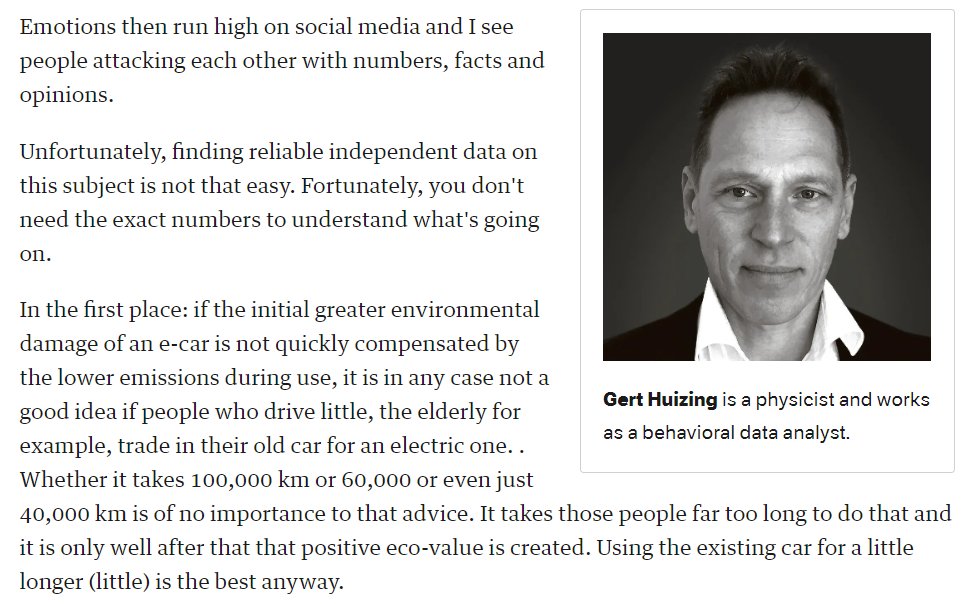Dutch quality newspaper @nrc just published an opinion stating that electric vehicles (EVs) emit more CO2 than they save.
That is not correct.
EVs emit about 3x less.
I research this at the @TUeindhoven.
Let me explain the mistakes in the opinion piece.
nrc.nl/nieuws/2023/05…
That is not correct.
EVs emit about 3x less.
I research this at the @TUeindhoven.
Let me explain the mistakes in the opinion piece.
nrc.nl/nieuws/2023/05…

The piece replaces numbers by 3 bad rules of thumb:
1) Exception: EVs bought by people who drive little.
2) Minimal impact: EV production emits CO2 sooner than it saves CO2.
3) Error: EVs drive on fossil fuel while the mix is not 100% green yet.
1) Exception: EVs bought by people who drive little.
2) Minimal impact: EV production emits CO2 sooner than it saves CO2.
3) Error: EVs drive on fossil fuel while the mix is not 100% green yet.
1) Exception: EVs bought by people who drive little.
This is true. An EV earns back it's extra emissions during it's first 30k km's or so. So if you e.g. drive 5k km per year: drive your old car as long as possible.
This is true. An EV earns back it's extra emissions during it's first 30k km's or so. So if you e.g. drive 5k km per year: drive your old car as long as possible.

However, most people who buy a new car, especially an EV, drive a lot.
The low mileage drivers, while theoretically interesting, are irrelevant for the large majority of buyers.
So while the argument is true, actual calculations would show it's largely irrelevant.
The low mileage drivers, while theoretically interesting, are irrelevant for the large majority of buyers.
So while the argument is true, actual calculations would show it's largely irrelevant.
2) Minimal impact: EV production emits CO2 sooner than it saves CO2.
Again, calculations can help. Because contrary to what Gert Huizing writes in @nrc, the first thing you should ask yourself is: *how* bad is it when we emit CO2 5 years faster?
Again, calculations can help. Because contrary to what Gert Huizing writes in @nrc, the first thing you should ask yourself is: *how* bad is it when we emit CO2 5 years faster?

CO2 stays in the atmosphere for many centuries.
Focusing on the fist 5 years is like focusing on the first 400 meter of the marathon.
Buying a different car because it is faster on the first 400m is bad advice when you must drive a marathon.
Numbers would show ~1% extra impact.
Focusing on the fist 5 years is like focusing on the first 400 meter of the marathon.
Buying a different car because it is faster on the first 400m is bad advice when you must drive a marathon.
Numbers would show ~1% extra impact.
3) Error: EVs drive on fossil fuel while the mix is not 100% green yet.
Especially people schooled in classic experiments make this error. The problem is that you assume everything stays the same except for the EVs and then you say: we could have cut gas or coal without EVs.
Especially people schooled in classic experiments make this error. The problem is that you assume everything stays the same except for the EVs and then you say: we could have cut gas or coal without EVs.

I've written a long funny thread about it in the past:
Please read that first if I don't convince you here but in a nutshell: using this approach you can argue that every electric appliance drives on coal because you would save coal if you turn it off.
https://twitter.com/AukeHoekstra/status/1620525765334036481
Please read that first if I don't convince you here but in a nutshell: using this approach you can argue that every electric appliance drives on coal because you would save coal if you turn it off.
It is often used to argue that heat pumps and EVs are extra bad but somehow never to argue that inefficient freezers or industrial processes are extra bad.
You can use this approach to make EVERY demand run on coal by saying: look what happens if THIS demand goes away!
You can use this approach to make EVERY demand run on coal by saying: look what happens if THIS demand goes away!
And even if it where true (which it isn't) you should take time of use into account. EVs mainly charge during the night when the amount of wind is high. Still apart from the fact that many EV drivers (and all public chargers) buy green electricity.
So he uses two numerically irrelevant rules of thumb and then adds an error to argue that you can tell an EV is worse without number crunching.
I am very glad most policy maker don't go with gut feeling and erroneous assumptions like Gert Huizing does here.
I am very glad most policy maker don't go with gut feeling and erroneous assumptions like Gert Huizing does here.
The correct approach is to take an average EV driver, the calibrated CO2 effect, and the average electricity mix (or the actual mix on an hourly basis).
If you are able to make those calculations you find EVs emit about 30% of CO2 in 2023.
If you are able to make those calculations you find EVs emit about 30% of CO2 in 2023.
https://twitter.com/AukeHoekstra/status/1333192338139701249?s=20
Powerful addition: the ETS system in the EU puts an emission ceiling in place.
Simply put: if your EV uses extra electricity, CO2 prices will force the market to replace coal with low carbon electricity for the consumption of your EV.
Simply put: if your EV uses extra electricity, CO2 prices will force the market to replace coal with low carbon electricity for the consumption of your EV.
https://twitter.com/DanielSpiro1/status/1658520813266403332?t=5QGMnMZwIxN9cLDu1lSf1Q&s=19
• • •
Missing some Tweet in this thread? You can try to
force a refresh

 Read on Twitter
Read on Twitter






